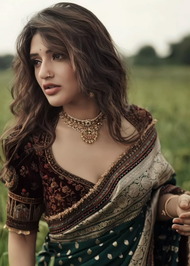
Synopsis
Cast & Crew
Puratawan: The Ancient Movie Review : Sharmila Tagore delivers a pitch-perfect performance in this drama
The film unfolds in a gentle, non-linear fashion, interweaving memories and moments to slowly reveal the emotional architecture of its characters. The editing, by Aditya Vikram Sengupta, is sharp and economical. Certain storylines, like Ritika’s relationship with Rajeev (Indraneil Sengupta), feel underdeveloped, perhaps intentionally so, allowing space for the film's visual and emotional textures to take centre stage.
Ghosh’s attention to detail is evident in both character and setting. The camera lingers on the faded beauty of old spaces – the cracked geometry of skin, the play of light on still water – evoking a poignant sense of time and memory. Alokananda Dasgupta’s music, particularly the haunting Dooray (sung by Shreya Ghoshal and penned by Rajeshwari Dasgupta Ghose), beautifully complements the film’s mood.
Sharmila Tagore delivers a deeply moving performance as Ritika’s formidable yet tender mother. Her portrayal is subtle and precise – every pause, every glance layered with meaning. The film gently reminds us of her age, but never lets it define her. Rituparna Sengupta is equally compelling as Ritika, capturing a woman pulled between personal obligations and professional demands. Indraneil’s quiet presence adds weight to his otherwise restrained role, while Ekavali Khanna makes a brief but notable appearance as Ritika’s friend.
Puratawn-The Ancient addresses the often-overlooked emotional terrain of an ageing population with sensitivity and grace. Though the ending feels somewhat hurried, the film remains a thoughtful meditation on memory, identity, and the quiet transformations within families. With its strong performances, evocative visuals, and resonant music, it definitely makes for a good watch this Naboborsho.
In-depth Analysis
Our overall critic’s rating is not an average of the sub scores below.
Users' Reviews
Biswajit Patra15 days ago
FollowThe film features Sharmila Tagore, Rituparna Sengupta, Indraneil Sengupta and Brishti Roy in the lead roles.<br/>Sharmila Tagore, at 80, brings an aristocratic aura due to her storied career and polished screen presence, which one may feel clashes with the intended mood of a middle-class Bengali character grappling with memory loss. It may be noted that her character, Kumud, is from an elite background (an ancestral home in Konnagar suggests a certain social standing), but the film aims for an everyman relatability in its exploration of aging. Her refined demeanor indeed creates a disconnect, as the character seems to be meant to embody the understated struggles of a less glamorous middle-class life. However, her ability to convey vulnerability through minimalism—her “quivering voice” and “vacant eyes” are highlighted as transcending her polished image are worth mentioning. Yet, her inherent sophistication overshadows the gritty realism one has expected, this somewhat disrupts the film’s emotional authenticity. <br/>Nuances of Middle-Class Bengali Identity: Although Tagore’s performance may be described as layered, the film’s English-heavy dialogues and her urban, cosmopolitan vibe dilutes the cultural specificity of a Bengali middle-class character. Traditional nuances—like colloquial Bangla mannerisms or the lived-in chaos of a middle-class household— feels absent, as her portrayal leans too polished or detached. Rituparna Sengupta’s Casting: Appearance and Mood: Rituparna Sengupta, playing Ritika, the daughter, is a Bengali cinema stalwart known for her expressive roles. However, one may argue that her appearance hinders the mood, possibly due to her glamorous screen persona or stylized acting style, which sometimes feel too “filmy” for the subtle, grounded tone Puratawn aims for. Although she tries her best to build her chemistry with Tagore, but her subplot (marital issues with Indraneil Sengupta’s Rajeev) as rushed, suggesting her performance doesn’t fully mesh with the film’s introspective core. Her looks or mannerisms at times feel polished or performative, and it undermines the authenticity of a middle-class elite Bengali woman navigating personal and familial crises. Missing Nuances: Rituparna’s characters often carry a larger-than-life quality, even in realistic roles. If Puratawn requires a more restrained, lived-in portrayal to capture the elite-yet-middle-class Bengali ethos (e.g., subtle class markers like thriftiness or cultural pride), her star presence somewhat overshadowed these details. The non-linear narrative and focus on Tagore’s character also limit her ability to fully embody the nuances of typical bengali characters.<br/>Criticisms apart, congratulations to the Suman Ghosh for delving into such a meaningful premise he ventured to convey through the film.






















































































































































0/5